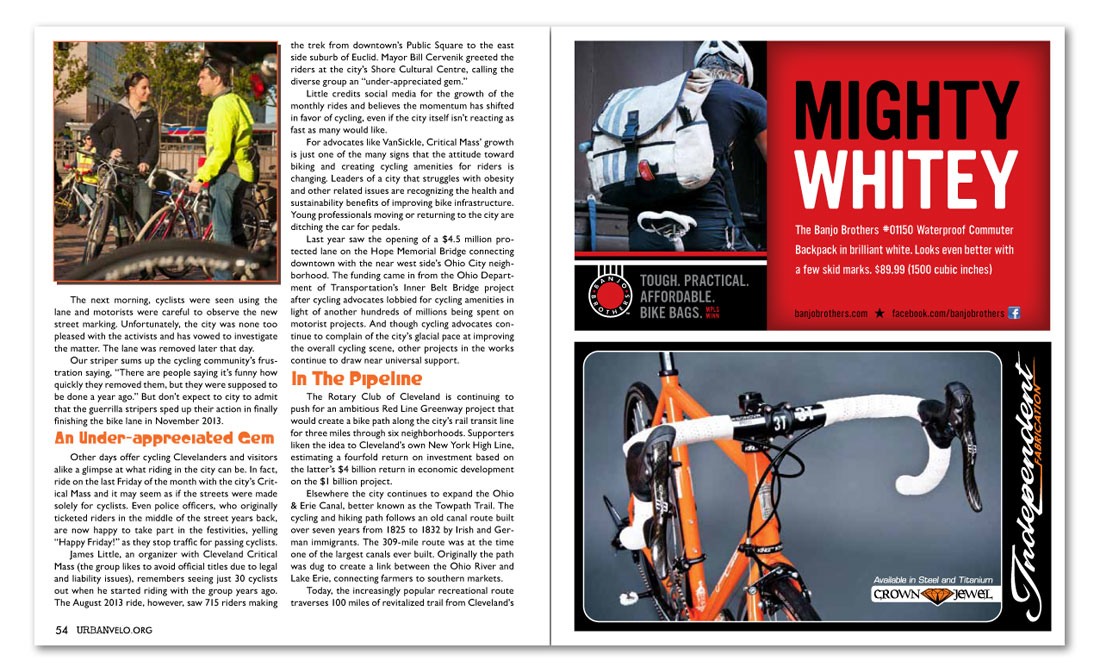


The next morning, cyclists were seen using the lane and motorists were careful to observe the new street marking. Unfortunately, the city was none too pleased with the activists and has vowed to investigate the matter. The lane was removed later that day.
Our striper sums up the cycling community’s frustration saying, “There are people saying it’s funny how quickly they removed them, but they were supposed to be done a year ago.” But don’t expect to city to admit that the guerrilla stripers sped up their action in finally finishing the bike lane in November 2013.
An Under-appreciated Gem
Other days offer cycling Clevelanders and visitors alike a glimpse at what riding in the city can be. In fact, ride on the last Friday of the month with the city’s Critical Mass and it may seem as if the streets were made solely for cyclists. Even police officers, who originally ticketed riders in the middle of the street years back, are now happy to take part in the festivities, yelling “Happy Friday!” as they stop traffic for passing cyclists.
James Little, an organizer with Cleveland Critical Mass (the group likes to avoid official titles due to legal and liability issues), remembers seeing just 30 cyclists out when he started riding with the group years ago. The August 2013 ride, however, saw 715 riders making the trek from downtown’s Public Square to the east side suburb of Euclid. Mayor Bill Cervenik greeted the riders at the city’s Shore Cultural Centre, calling the diverse group an “under-appreciated gem.”
Little credits social media for the growth of the monthly rides and believes the momentum has shifted in favor of cycling, even if the city itself isn’t reacting as fast as many would like.
For advocates like VanSickle, Critical Mass’ growth is just one of the many signs that the attitude toward biking and creating cycling amenities for riders is changing. Leaders of a city that struggles with obesity and other related issues are recognizing the health and sustainability benefits of improving bike infrastructure. Young professionals moving or returning to the city are ditching the car for pedals.
Last year saw the opening of a $4.5 million protected lane on the Hope Memorial Bridge connecting downtown with the near west side’s Ohio City neighborhood. The funding came in from the Ohio Department of Transportation’s Inner Belt Bridge project after cycling advocates lobbied for cycling amenities in light of another hundreds of millions being spent on motorist projects. And though cycling advocates continue to complain of the city’s glacial pace at improving the overall cycling scene, other projects in the works continue to draw near universal support.
In The Pipeline
The Rotary Club of Cleveland is continuing to push for an ambitious Red Line Greenway project that would create a bike path along the city’s rail transit line for three miles through six neighborhoods. Supporters liken the idea to Cleveland’s own New York High Line, estimating a fourfold return on investment based on the latter’s $4 billion return in economic development on the $1 billion project.
Elsewhere the city continues to expand the Ohio & Erie Canal, better known as the Towpath Trail. The cycling and hiking path follows an old canal route built over seven years from 1825 to 1832 by Irish and German immigrants. The 309-mile route was at the time one of the largest canals ever built. Originally the path was dug to create a link between the Ohio River and Lake Erie, connecting farmers to southern markets.
Today, the increasingly popular recreational route traverses 100 miles of revitalized trail from Cleveland’s
Independent Fabrication
Banjo Brothers